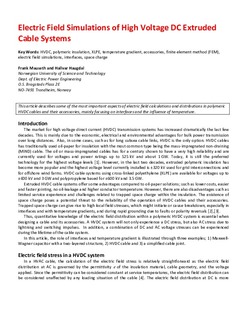| dc.contributor.author | Mauseth, Frank | |
| dc.contributor.author | Haugdal, Hallvar | |
| dc.date.accessioned | 2017-11-27T10:11:58Z | |
| dc.date.available | 2017-11-27T10:11:58Z | |
| dc.date.created | 2017-08-07T08:28:27Z | |
| dc.date.issued | 2017 | |
| dc.identifier.citation | IEEE Electrical Insulation Magazine. 2017, 33 (4), 16-21. | nb_NO |
| dc.identifier.issn | 0883-7554 | |
| dc.identifier.uri | http://hdl.handle.net/11250/2468103 | |
| dc.description.abstract | The market for high voltage DC (HVDC) transmission systems has increased dramatically the last few decades. This is mainly due to the economic, electrical, and environmental advantages for bulk power transmission over long distances. Also, in some cases, such as for long subsea cable links, HVDC is the only option. HVDC cables have traditionally used oil-paper for insulation, with the most common type being the mass-impregnated, nondraining cable. The oil or mass-impregnated cables have for a century shown to have a very high reliability and are currently used for voltages and power ratings up to 525 kV and about 1 GW. Today, it is still the preferred technology for the highest voltage levels [1]. However, in the last two decades, extruded polymeric insulation has become more popular, and the highest voltage level currently installed is +320 kV used for grid interconnections and for offshore wind farms. HVDC cable systems using cross-linked polyethylene (XLPE) are available for voltages up to +600 kV and 3 GW and polypropylene based for +600 kV and 3.5 GW. | nb_NO |
| dc.language.iso | eng | nb_NO |
| dc.publisher | Institute of Electrical and Electronics Engineers (IEEE) | nb_NO |
| dc.title | Electric Field Simulations of High Voltage DC Extruded Cable Systems | nb_NO |
| dc.type | Journal article | nb_NO |
| dc.description.version | submittedVersion | nb_NO |
| dc.source.pagenumber | 16-21 | nb_NO |
| dc.source.volume | 33 | nb_NO |
| dc.source.journal | IEEE Electrical Insulation Magazine | nb_NO |
| dc.source.issue | 4 | nb_NO |
| dc.identifier.doi | 10.1109/MEI.2017.7956628 | |
| dc.identifier.cristin | 1484412 | |
| dc.description.localcode | © 2017 IEEE. Personal use of this material is permitted. Permission from IEEE must be obtained for all other uses, in any current or future media, including reprinting/republishing this material for advertising or promotional purposes, creating new collective works, for resale or redistribution to servers or lists, or reuse of any copyrighted component of this work in other works. | nb_NO |
| cristin.unitcode | 194,63,20,0 | |
| cristin.unitname | Institutt for elkraftteknikk | |
| cristin.ispublished | true | |
| cristin.fulltext | preprint | |
| cristin.fulltext | postprint | |
| cristin.qualitycode | 1 | |
